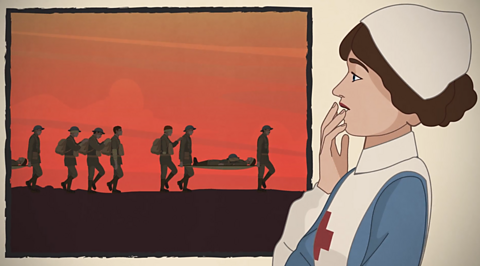On 12 November, the nation will pay its respects to the fallen as Remembrance Day is marked.
The members of the armed forces who gave their lives across conflicts through the years will be honoured, as will those who survived and the others who continue to support them.
±«Óătv Bitesize takes a look at some of the unique words and phrases that we often hear in association with this special occasion.
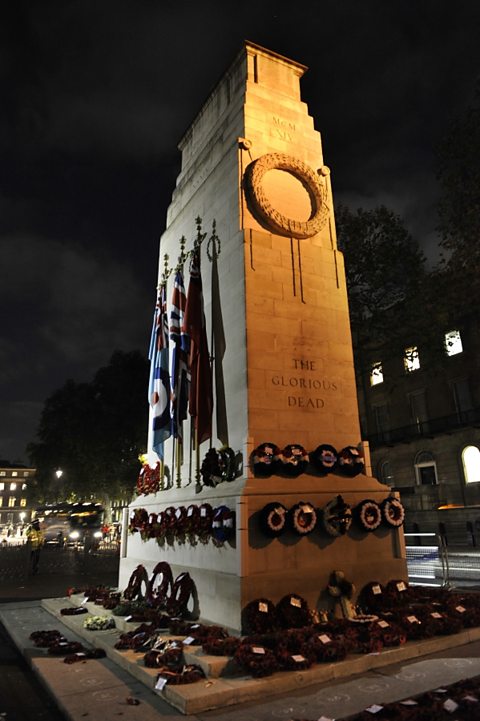
Cenotaph
The First World War led to many thousands of British soldiers losing their lives on the Front.
With none of the fighting taking place on home soil, when the conflict ended in 1918, paying respects to soldiers where they had died meant visiting the locations of the Western Front trenches in France and Belgium.
London's Cenotaph was built in Whitehall in 1919 to remember those who had died in the war between 1914 and 1918.
The reason itâs called a Cenotaph is because the name describes a monument to honour those who have died and are buried in another location and comes from the Greek word for âempty tombâ.
It was designed by the architect Sir Edwin Landseer Lutyens and was only intended to stand in place for a week, in recognition of the first Peace Day celebrations in July 1919.
But it was a popular part of the celebrations, so much so that a permanent version was ordered.
Built from Portland stone (the original was a temporary structure formed of wood and plaster), it was in place to be unveiled by King George V on Armistice Day 1920.
More than 100 years on, it remains a centrepiece of Remembrance Day in the United Kingdom.

Legion
When you wear a poppy in memory of those who fell, youâre also supporting the work of the Royal British Legion. Established on 15 May 1921 (the âRoyalâ was added to the name on its 50th anniversary in 1971), its intention was, and remains, looking after service personnel while theyâre in action and also long after theyâve hung up their uniform.
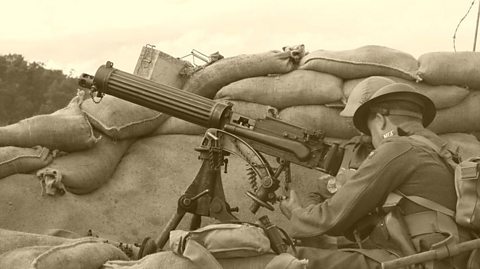
That help was needed in 1921 as four years of war had had a detrimental effect on the British economy. Unemployment stood at two million and many had returned from the front with little prospect of gainful employment. This impacted even more on the soldiers who had sustained life-changing injuries and of the six million who fought, 1.75m returned with a disability of some description. For half of them, those injuries left permanent damage.
Legion is a fitting name. Although it dates back to the Roman army, with specific military reference to an infantry between 3,000 and 6,000 troops, in later years it has come to refer to a large multitude of people, as the Royal British Legion is.
The first Poppy Appeal was in 1921 and raised more than ÂŁ100,000. This was a vast sum at the time and was used to help the war veterans who desperately needed it. That help has been ongoing ever since.
To find out more about the history of the poppy in Remembrance Sunday, see this article from C±«Óătv's Newsround.
March Past
The March Past is one of the fixtures of the Remembrance Day service and is also organised through the Royal British Legion. Veterans from all areas of the Armed Forces march in uniform, grouped into their respective organisations such as the Army, Navy and Royal Air Force. The March Past follows the 11am service of Remembrance and involves up to 10,000 veterans from World War Two and other conflicts marching past London's Cenotaph each year.
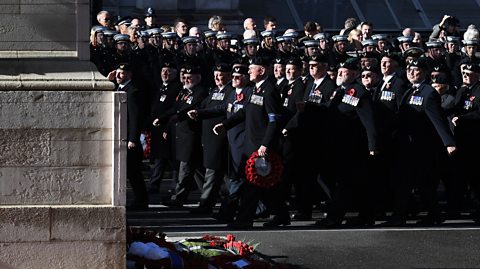
During the March Past, a member of the Royal Family will take the salute from the veteran organisations. In 2022, this role was carried out by Prince Edward, the Earl of Wessex - who became Duke of Edinburgh in March 2023.
There is a high level of organisation involved, including the order in which the various organisations march. The number of marchers is capped at 10,000 which helps to ensure nobody has to stand for longer than is necessary.
Armistice
An armistice originally meant a brief truce or ceasefire between warring factions, with the Oxford English Dictionary listing references which date back to 1677.
It now refers to a complete end to hostilities, as happened in November 1918 when World War One came to an end. France, Great Britain and Germany signed an armistice at 5am on a train in the Forest of Compiegne in France - an agreement to end conflict between them. In reality, the war continued beyond this date as the peace negotiations continued, but it remains the defining moment when more than four years of fighting came to an official end.
Eleven
The number 11 is significant on Remembrance Sunday because it features many times in the circumstances surrounding the 1918 armistice. It was agreed that hostilities would officially cease at 11am on 11 November. In other words, itâs the 11th hour of the 11th day of the 11th month of the year.
The two-minute silence held around the UK every Remembrance Sunday to respect those who gave their lives begins at 11am for this reason.
Unknown Warrior
A symbolic gesture was made in 1920 to bring one member of the armed forces, buried in an unmarked grave on the Western Front, back to a grave on British soil.
The idea came from reverend David Railton who had spent time on the World War One frontline as a chaplain. He believed this would commemorate those who would not be coming home from battle, especially if the place where they fell could never be known.
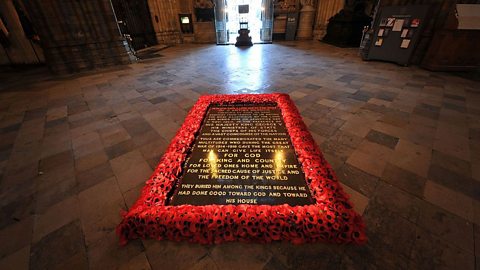
There is no definitive version of how the Unknown Warrior came back, but the one most experts seem to agree on is this. Between four and six bodies were exhumed from different parts of the Western Front, all areas that saw heavy British battle. On 7 November 1920, the bodies, each covered in a union flag, were brought to the chapel at St Pol in northern France.
Brigadier General LJ Wyatt, the commander of British troops in France and Flanders, selected one of the bodies at random. The ones that werenât chosen were reburied while the solitary selected figure was repatriated via Dover on the HMS Verdun. The number of bodies involved in the selection process is disputed, with some accounts saying four, others six.
On 11 November 1920, the body of the Unknown Warrior was drawn through the streets of London to the newly unveiled, permanent Cenotaph. A two-minute silence took place and, following it, the Unknown Warrior was then taken to its final resting place in Westminster Abbey. More than one million people visited the grave to pay their respects in the following week. The Unknown Warrior is still one of the most visited war graves in the world.
Silence
It was a letter in the London Evening News which first proposed the possibility of paying respects to those who gave their lives in war with a short period of silent, respectful reflection.
Australian journalist Edward George Honey penned the letter which appeared on 8 May 1919, just over six months after the 1918 armistice. When King George V became aware of the idea, he was in full favour and made a Royal Proclamation that a two minute silence should be observed.
It happened for the first time at 11am on Thursday, 11 November 1919, the very first Armistice Day - what we now call Remembrance Day following World War Two.
A two minute silence has been observed on Remembrance Day ever since.
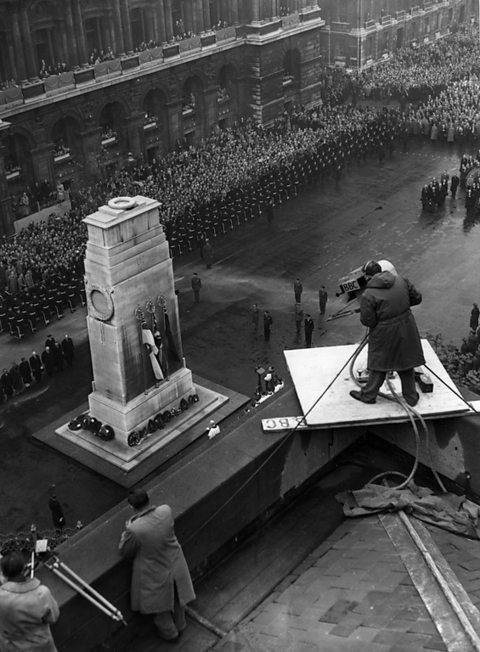
Broadcast
For those who cannot attend the Cenotaph to pay their respects, or make it to a remembrance service closer to home, the National Service of Remembrance has been broadcast from London nearly every year by the ±«Óătv since 1928.
The corporationâs first Director General, Lord Reith, had long been keen to bring the country together in a shared act of remembrance in this way.
Negotiations with the ±«Óătv Office made it possible for the first time in 1928 when an outside broadcast was made from the Cenotaph for ±«Óătv Radio.
The only time the National Service of Remembrance has not been broadcast was during the suspension of programmes for World War Two.
Former Question Time host David Dimbleby was the ±«Óătvâs commentator for the event in 2022.
This article was first published in November 2019 and updated in October 2023.

The stories behind our Remembrance Day music
From the Last Post to Nimrod, we take a look at the history behind this familiar Remembrance Day music.
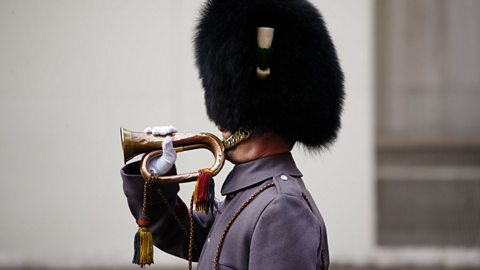
Remembrance Day: What is it and what happens?
Why do we have two minutes of silence, what do the poppies mean and when did it all begin?
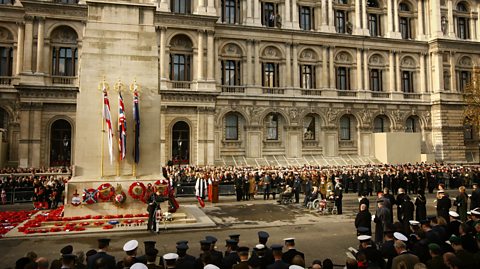
What was life like on the front line in World War One?
Life in the trenches of World War One was very difficult. The first day of the Battle of the Somme, in 1916, was the deadliest day in the history of the British army.
